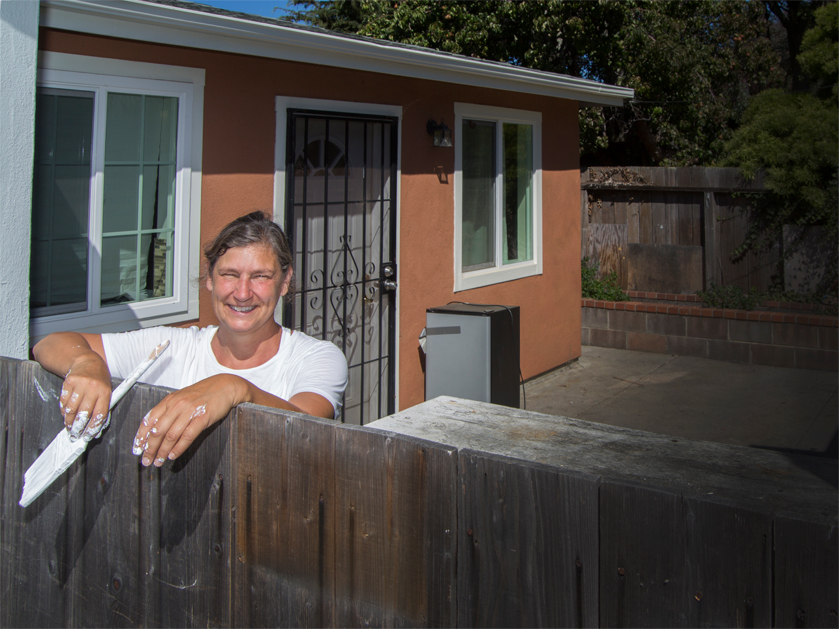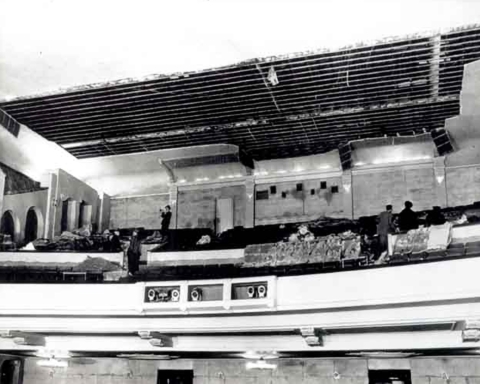Pam Dorr – who helped design prototype $20,000 cottages for Alabama’s rural poor – had some idea about the housing shortage before she decided to move back to the Bay Area in 2017.
“I just didn’t know how crazy it was,” she says.
After renting for awhile, she lost out more than 20 times trying to purchase a house before she put up an all-cash offer a few months ago and finally closed on a home in Half Moon Bay for $1,136,000.
Then she enlisted her cousins and others to completely tear it apart and rebuild it before she moved in.
“It’s what I call a ‘gut rebuild,’” Dorr says, with a laugh.
The residence, which was built in 1903 and has a rental unit in the back yard, had cast iron plumbing and knob-and-tube wiring. Dorr discovered newspapers from the 1880s behind the recycled barn wood walls. She and her energetic crew installed new electrical and plumbing systems, replaced the HVAC and redid the flooring.
Dorr’s adventure would be just another eye-rolling example of the Bay Area’s notoriously high-cost real estate but for her perspective as an innovator in affordable, modular housing. She grew up in Pacifica, where post-World War II construction provided homes for veterans with GI loan applications in their pockets and young families to house. Builder Andy Oddstad was a major developer in Pacifica then and also constructed about 1,700 homes in Redwood City in the Sterling Highland, Farm Hill and Farm Hill Estates subdivisions where a Baby Boom generation grew up. The pace was so brisk that one day, Oddstad’s crews poured one foundation an hour, according to his daughter, Sandy Nathan, and reportedly finished eight or nine houses a day.
Though the drivers of the housing crisis today may be different, it’s news to no one that it is every bit as pressing. What to do about it? From building tiny houses or high-densities along transit corridors, from rent control to rewriting zoning restrictions, there is no shortage of solutions, often contradictory.
Dorr is director of housing at a nonprofit called Soup, which helps people plant modular accessory dwelling units – known as “ADUs” – in their back yards. Sometimes called “in-law” or “granny” units, sometimes stand-alone units and sometimes added to the main house; ADUs have picked up a lot of political steam in recent years – and interest from homeowners. The units can serve multiple, and changing multigenerational needs, such as housing a college graduate who comes back home, a son or daughter trying to save up a down payment – or “granny” herself. ADUs may provide a rental unit for a teacher or a young techie and income for the homeowner. A senior who doesn’t want to move could house a caregiver in an add-on unit.
Unlike during the post-war building binge, ”It’s not going to be one person who comes in and saves us with this huge amount of mega-housing,” Dorr contends. “It’s each one of us making a difference and a choice. At one time we needed these larger residential lots, and now a lot of us are finding we don’t need much space in our back yard. It’s actually wasted space that could be better utilized.”
Four hundred forty-eight square miles of acreage in the county seems like a lot to work with, but easily developed, flat land is essentially built out. About 75 percent of the county is permanent open space of some kind, such as parks, the watershed, and agricultural land. “And so that only leaves about 25 percent, basically along the Bayfront,” says Bill Lowell. The long-time San Mateo County Housing Department Director returned from retirement to assist with a 54-member task force that examined ways of closing the enormous gap between job creation and housing. The year-long effort involved all 20 cities and partnerships from business, nonprofits and more. One of the results was a collaborative effort that Lowell coordinates called “Home for All,” which attempts to provide information and tools to increase the housing supply.
There are about 270,000 homes in the county of all types, Lowell continues, and about two thirds of them (200,000) are single-family homes. The majority were built before the 1980s, when housing production “kind of fell off a cliff” for various reasons. Very little, he adds, has been produced since the 1980s.
A referendum in 1982, for example, stopped development of South Shores, which would have closed the “gap” between Redwood Shores and Whipple Avenue and added 5,500 homes. The 42-vote loss turned out to be the beginning of the end for the bayside development, which is now part of a federal wildlife refuge. A plaque there honors the memory of Ralph Nobles, a leader of that 1982 campaign, who lived in Farm Hill. More recently, DMB Pacific Ventures’ proposal for about 12,000 homes on Cargill-owned salt ponds east of U.S. 101 between Woodside and Marsh roads unleashed an epic environmental battle. The plans were withdrawn in 2012.
Between 2010 and 2016, meanwhile, the county gained 79,000 jobs and only 4,941 homes, adding to the upward pressure on rents and home prices.
“The message that we have is that everyone is affected by the jobs/housing gap,” says Deputy County Manager Peggy Jensen, who worked with the Home for All task force. “We all have family, friends that are moving away. We have this traffic congestion that is really a function of the fact that people are moving as far as they need to to be able to afford a home and then driving back here. And then it’s affecting our local economy because our businesses can’t recruit people and they are losing jobs to elsewhere.”
Among the ways identified to ramp up housing production is offering developers incentives, such as density bonuses and expedited permitting to build along transit corridors or to add affordable units. Private employers and public agencies are already building on land they own for employee housing. Both College of San Mateo and Cañada College have workforce housing on campus.
At the micro level, HIP Housing’s Home Sharing Program matching owners and home seekers provides technical assistance to help with screening and connections. HIP representatives in July attended a meeting at the Edgewood Park home of Dani Gasparini, which brought together officials from Sequoia Hospital, the city and neighbors to discuss how the housing crisis is impacting the ability to hire and retain nurses. Chief Operating Officer/Chief Nurse Executive Sherie Ambrose says Sequoia has many long-time employees who live in the area but, as they retire, both housing costs and very long commutes make it tough recruiting their successors.
“This is a neighbor-to-neighbor issue,” Gasparini says. “We don’t want our Sequoia Hospital not to have the best nurses because they can’t afford to live here.” Edgewood Park has many large homes, and several neighbors with spare bedrooms expressed interest in taking in a renter or even in building an ADU. HIP’s matchmaking expertise could simplify things. Perhaps only a few people will be helped, Gasparini adds, but “they don’t have to be grand solutions all the time.”
Partly because of the way the county developed — primarily with single-family homes — ADUs are looked at as a low-key way to add bedrooms to a community, and provide an option for renters who can’t afford living in the new high-rise buildings closer to downtown, or prefer living in a neighborhood.
A 2016 change in state law also made it much easier for property owners to get approval from local government. The new rules limited the ability of localities to require additional parking, allowed garage conversions by right, and controlled whether or not fire sprinklers and water meter connections would be required.
As word has gotten out, interest in ADUs has grown. Property owners are still subject to setback, lot coverage and other zoning standards, as well as substantial fees, but it has definitely become easier to add a unit.
“We have been doing ADUs before the law changed,” says Brian Villavicencio, associate AIA with the architectural firm headed by D. Michael Kastrop, AIA. “And when the law changed, it was just a big sigh of relief. … It’s not a slam dunk but it’s easier than what we were used to.” Lorianna Kastrop, The Kastrop Group’s vice president and controller, adds that the requirement for onsite parking for the additional unit “was the hardest thing because most people don’t have extra garage space or extra driveway space.”
Redwood City had already relaxed its rules in 2015 and seen an uptick in permits — from five to 27 in 2016 and then 34 in 2017. “We are trying to make it as easy as we can by providing the tools to set the expectations as early as possible,” says Planning Director Steven Turner.
Only 11 ADUs have been built in San Carlos in the last five years. Al Savay, the community and economic development director, sees a limited role for ADUs, in part because of small lot sizes in areas of the city, as well as sloped parcels that could require retaining walls. Savay notes that some communities are eyeing making it easier to wall off interior walls for “junior ADUs,” which make them more feasible.
Though some might add a unit to generate income or to alleviate the housing shortage, probably more often it’s to house family members.
Joyce Jordan found that her 2,600-square-foot home in Emerald Hills was more than she could handle after her husband, Larry died. She sold it and then found herself among those getting in line when new rental units became available. “You couldn’t get there fast enough,” she recalls. “You’d see a line of people and someone walking out with the lease.”
After renting for a while with her daughter, a win-win situation came along in the form of a house for sale with an in-law unit. Jordan’s daughter and son-in-law, Maeve and Steve Sundstrom, bought the house four years ago and renovated the two-bedroom, two-bath unit for her. The below-market rent they charge helps cover their mortgage, and she gets to be around them and her granddaughter, who is now 10. If things hadn’t worked out as they did, “I would have had to find a place to rent, and I don’t know where I’d be,” Jordan says. “I don’t have a clue.”
When Beth Snell added a 500-square-foot ADU to her Redwood City home in 2012, it was for her mother, who was shelling out thousands of dollars at an assisted living facility. After her mother passed away in 2016, Snell’s 49-year-old son and his girlfriend moved in. He’s able to save his money to buy a home in the near future. Working with a contractor friend who gave her a good price, Snell was able to add the unit for about $70,000.
Dave Holmquist, who is a warehouse manager, comes from a pioneering Redwood City family. He recently moved into a two-story, 598-square-foot “man cave” that he was able to build behind the Woodside Plaza-area house where his sister’s family lives. The siblings inherited the house where their grandparents once lived. Were it not for the ADU, Holmquist says, “I probably wouldn’t be in Redwood City. I’d probably have had to move out of state.”
Unfortunately, he started the project before the state loosened the rules. He had to put in extras like a parking space and fire sprinklers, adding thousands of dollars to the $200,000-to-$250,000 cost.
People who call the Kastrop office with questions about ADUs often underestimate how long it takes to get permits and approvals, or what’s involved in construction. One of the biggest misconceptions Villavicencio hears is “I thought I could just put drywall in my garage and rent it out.”
“With almost every residential client, it’s brand new,” Mike Kastrop adds. “They’ve never done it before. The learning curve is enormous.”
The county has gone the extra mile in compiling information to demystify the process. The Home for All website includes a calculator where people can enter variables – their city, the square footage, financing details – and get estimates for the cost, how much of that is fees, a projected rate of return and break-even point. A workbook in plain English also walks them from the idea stage through budgeting, permitting, construction and move-in. “We hope it will be the tool that will help people get motivated,” says Deputy County Manager Jensen.
The “nonprofit contractor” Soup tries to make things even simpler, taking care of all project management including working with engineers and obtaining permits. Soup brings in factory-built modular ADUs ready to occupy, which are delivered to a homeowner’s backyard and installed on the waiting foundation. The units have already been inspected and approved by the California Department of Housing, according to Dorr, so they should meet the local jurisdiction’s requirements. Soup’s project management fee (about $5,000) is included in the cost of the unit. The grand total for a 330-square-foot, one-bedroom home runs about $150,000 to $175,000, Dorr says.
Dorr was hired earlier this year to start up Soup’s housing program, which is new. Soup has one fully permitted modular (in Menlo Park), has broken ground on one in Sunnyvale, and about 10 others “in the pipeline,” Dorr says. They’re new, she points out, which has made the permitting process longer than expected. Homeowners who work with Soup are to agree to rent the unit for the first three years to low -income tenants.
“Densifying” single-family neighborhoods, even one ADU at a time, isn’t without controversy, because each introduces more cars on streets built at a time of one-car families. Similar concerns were raised in August on Nextdoor when a company called Bungalow.com leased a single-family home in the Mount Carmel area and began renting out the bedrooms. Despite the outcry, the City Council declined to open a review of such shared living arrangements.
ADUs may chip away at the shortage, but it’s the high-density complexes mushrooming in downtowns and along the El Camino Real that are capable of producing big numbers. Some grumble that people are being packed like popcorn into these congested corridors, but the units are close to Caltrain and SamTrans and also put downtown stores, restaurants and other services in walking distance.
Redwood City got a head start on downtown development, and its pace and scale remain controversial as residents complain that their hometown has become unrecognizable. But other cities – notably South San Francisco, Millbrae, San Mateo and neighboring San Carlos – have also been approving new projects. Cities have been given target numbers for the housing they must produce by 2023 – the Regional Housing Needs Allocation – and the state is using transportation dollars as carrots and sticks.
“We need a significant number of units in higher densities near transit to make an impact,” says San Carlos’s Savay. Several such projects are currently under construction, including the Wheeler Plaza development on Laurel Street (109 condos), and the 202-unit Trestle apartments on El Camino Real, north and south of Holly Street.
If there’s a project that hits on all points as “infill,” it would be that development. Built on land owned by Caltrain, Trestle lies between the railroad tracks and El Camino Real, yet the units are filling right up. When the apartment project was first proposed, it had twice as many units but it was downsized in response to community concerns.
Redwood City has exceeded its regionally assigned target for market-rate housing but falls short for “affordable” housing. Countywide, those on the low-to-moderate end of the income scale are most vulnerable, and solutions include making developers set aside affordable units within their projects or pay into housing funds.
Then there are “tiny houses.” Peter Stiehler of Catholic Worker Hospitality House in San Bruno had a mini-house-on-wheels built as a prototype and wishes a school district or another governmental entity would consider allowing a cluster of them with some shared facilities, like showers, to make them a realistic option for low-income people.
St. Francis Center is a multi-service entity in North Fair Oaks with a school, a food and clothing pantry and other services for the working poor. Dominican Sister Christina Heltsley, who is St. Francis’s executive director, says parents working multiple jobs to feed their families can’t afford rent and are leaving the Peninsula – a loss not just for them but for the diversity of the entire community. “We would really like to stabilize this neighborhood with families,” she says.
To staunch the exodus, St. Francis Center began purchasing property in the neighborhood to keep rents affordable — from homes to the most recent transaction, a 48-unit apartment building on Buckingham Street that closed Sept. 25. Bottom line: St. Francis Center owns 10 buildings with 135 housing units valued at about $61 million. For Sister Christina, taking on $21,750,000 in debt for the Buckingham apartments took a leap of faith. But donations, including $1 million from Stanford University and $5 million from John and Sue Sobrato, have brought St. Francis’s total mortgage debt down to $12 million. The apartments will be called Casa de Sobrato.
“It sounds so bold,” she concedes. The problem, however, is so urgent that “We need all hands on deck, but we can’t wait until we have all hands on deck.”
Governor Jerry Brown recently signed some 15 bills aimed at encouraging housing. A bill by State Assembly Speaker Pro Tempore Kevin Mullin (D-South San Francisco) that is now law makes it easier for schools to put housing for educators on land that currently isn’t in use.
During the Great Recession, Gov. Brown did away with redevelopment agencies, which had been the largest source of governmental funding for affordable housing, and Mullin has hopes that some targeted form of redevelopment can be restored. “I don’t think anybody’s very honestly talking about absolutely solving the affordable housing crisis,” he says. “But can we make a major dent? Yes, I think we could.”
He also envisions a bipartisan look at reform of the California Environmental Quality Act. “I think you have to do some form of CEQA streamlining,” he adds. “Too many projects get derailed.” No one is seriously talking about eliminating local land use control, but the state can provide incentives for cities to meet their affordable housing goals, he maintains.
Some blame large employers for creating the problem and say they should be doing more to create housing. While Mullin agrees that “much more can be done in that regard” on corporate campuses, the housing crunch is the byproduct of prosperity in what has always been a high-cost area. “I think the economy inevitably will cool but nobody’s rooting for a recession.”
Mullin, whose spent five years on the South San Francisco City Council before going to Sacramento, believes residents have become more receptive to housing projects, but the challenge is to engage them so they “feel this is not being rammed down their throats.” There’s a sweet spot, of sorts. “People need to feel like they’re being heard and that their concerns are being properly addressed. … It’s about how much change a community can properly absorb without people feeling as though their quality of life is being harmed.”
Isabella Chu is part of a group called Redwood City Forward, a land advocacy group. The 50-year-old Friendly Acres resident regularly attends City Council and Planning Commission meetings and applauds the transformation downtown. She speaks up because the people most impacted by a housing undersupply have less time than housing opponents to testify at council meetings. “I feel like there is a need for support and a balanced voice,” Chu says.
When Dorr bought her fixer-upper in Half Moon Bay, the applicants for the one-bedroom back yard unit included three teachers who wanted to share it. So did four hotel workers. She rented it to a local couple expecting a baby.
Before returning to the Bay Area, she spent 15 years in Alabama, first at Auburn University Rural Studio, where her challenge was to design a $20,000 home that could be reproduced anywhere. Dorr concedes that it would cost 10 times as much in San Mateo County. But her mission at Soup is to give individuals a way to use what they have to make a difference.
After World War II, she points out, “there was land available. I think one of the things we’re recognizing now is how precious land is. And ADUs help us take advantage of the land that we do have. There’s no land cost when you’re building an ADU. You already have it.”
When all is said and done, in a county where a good seventy-five percent of the land is off-limits for development, is “solving” the housing shortage as was done in the post-war era even realistic? John Maltbie, who will retire in November after 26 years as San Mateo County manager, is not sanguine.
“You have to recognize that this county is primarily built out and has been for a number of years,” he says. “We have a huge amount of open space that’s owned by the state and federal governments and that’s never going to change. So what that leaves you with is … really doing things around the edges, not that it is not important, but you’re not going to bend the cost curve. The cost curve is driven by jobs in the Bay Area, and until that changes, the cost of housing is going to continue to ratchet up and up.” While he is “not hopeful we can build our way out of the crisis with new housing,” Maltbie maintains that the focus needs to be broader than that.
The alternative is to concentrate on building transportation systems to the east – to Tracy, Manteca and Stockton – that would get people to work in 40 minutes or less, he believes, “and recognize that for most people that work in Silicon Valley, their best housing alternatives are going to be in the Valley.” The county has for years provided transit passes for employees and now charters shuttles to bring them from the East Bay. Transit modes might include BART, high speed rail or who knows what an innovator in a new world of driverless-vehicles may come up with?
“We have to have the conversation about jobs, housing and transportation,” Maltbie says. “We talk about it on a piecemeal basis and never put the three topics together at the same time.”
Housing and transportation, Mullin agrees, are “two sides of the same coin so to speak from a policy standpoint. They’re so interrelated. So we’ve made great progress on transportation and simply not enough on housing. … The issue of solving the problem? I like to be aspirational,” he adds, “but we’re at such a big deficit in terms of jobs and housing, I think it’s about what can we do to make a dent and rebalance that jobs/housing ratio.”
Resources and websites:
• To read the complete report and progress that is being made on the various elements of San Mateo County’s Home for All Plan and to try out the online ADU calculator, go to homeforallsmc.org.
• For information on Soup and its modular units, visit soup.is. The kinds of modular units the nonprofit installs can be viewed at honomobo.com, a Canadian manufacturer.
• To read about HIP Housing’s services helping renters find housing, go to hiphousing.org.
• Abode Services is also equipped to help homeowners screen tenants and handle leasing on their behalf. For information, go to abodeservices.org.






